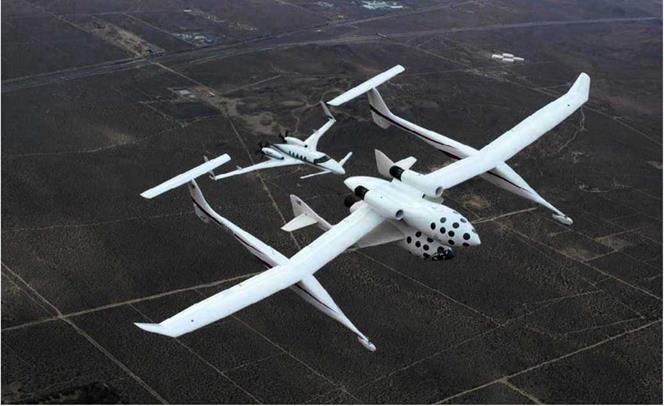First Flight Test (1C)
Thirty-two days after Scaled Composites revealed its space program to the world, SpaceShipOne was about to take to the air for the first time. “Here we are about to embark on a flight test program with a spaceship,” said Doug Shane, the director of the flight test program. “And we started off with an unmanned captive-carry flight just to make sure the interactions between the two airplanes were fine.” The first test flights off the ground were captive carries, where White Knight and SpaceShipOne took off attached together in the mated configuration and did not separate during the flight. This was just like a giant wind tunnel, but instead of an enormous fan blowing air on SpaceShipOne, White Knight moved SpaceShipOne through the

Ґ л
Fig. 7.2. SpaceShipOne took to the air for the first time on May 20, 2003, for an unmanned captive carry. A primary goal of the flight was to ensure that the two vehicles could safely fly while mated. Mojave Aerospace Ventures LLC, photograph by Scaled Composites
air. Figure 7.2 shows SpaceShipOne and White Knight during the first captive carry.
With Pete Siebold at the controls and Brian Binnie in its backseat as flight engineer, White Knight carried the unmanned SpaceShipOne to an altitude of 48,000 feet (14,630 meters), which would eventually be the approximate launch altitude. They reached a speed of Mach 0.53 after the 700 feet per minute (210 meters per minute) climb to this altitude. Siebold and Binnie flew for 1.8 hours and found that White Knight had excellent handling qualities and could perform the captive carry without any stability, interference, or vibration problems. SpaceShipOne was now ready for a pilot.
SpaceShipOne Now Manned (2C)
Within specifically designated airspace, Mike Melvill rode inside SpaceShipOne during a 2.1-hour-long captive-carry test flight. Aside
—
Flight Test Log Excerpt for 2C
Date: 29 July 2003
Flight Number Pilot/Flight Engineer
SpaceShipOne 2C Mike Melvill
White Knight 29C Brian Binnie/Cory Bird
Objective: First manned captive-carry flight of SpaceShipOne. A man-in-loop launch rehearsal and inflight checkout of all ship systems, including flight controls and propulsion system plumbing.
|
(source: Mojave Aerospace Ventures LLC, provided courtesy of Scaled Composites)
|
|
ґ
Fig. 7.3. Two months after SpaceShipOne’s first test flight, Mike Melvill became the first test pilot to get behind the stick of SpaceShipOne. This mission was a captive carry, though. The Starship, designed by Burt Rutan, flew as a chase plane. Mojave Aerospace Ventures LLC, photograph by Scaled Composites
V__________________________________________________________________________________________
r
Flight Test Log Excerpt for 3G
Date: 7 August 2003
Flight Number Pilot/Flight Engineer
SpaceShipOne 3G Mike Melvill
White Knight 30L Brian Binnie/Cory Bird
Objective: First glide flight of SpaceShipOne.
(source: Mojave Aerospace Ventures LLC, provided courtesy of Scaled Composites)
V__________________ )
from checking systems, Melvill preformed a full rehearsal for the first glide-test flight with Brian Binnie and Cory Bird, who crewed White Knight.
Figure 7.3 shows this test flight and the Starship chase plane trailing behind. Several chase planes flew alongside SpaceShipOne and White Knight at various stages during the flight test program. They monitored how SpaceShipOne performed from an external standpoint, and, should SpaceShipOne or White Knight run into difficulties, they provided a valuable extra set of eyes.
During this rehearsal, SpaceShipOne also practiced the communication that would take place, which included sending data and video down to Mission Control on the ground.
Although pilots trained to fly SpaceShipOne with the simulator and White Knight, this was the first time that a pilot could actually feel the forces on the controls during flight. After Melvill exercised all the different systems aboard SpaceShipOne, which included parts of the feather and propulsion systems, SpaceShipOne was ready for the big next step.
As White Knight came in for a landing, though, Melvill couldn’t help trying to land, even though SpaceShipOne still remained fixed to White Knight. From the chase plane video, SpaceShipOne7s elevons moved as White Knight flared for landing. Afterward, Melvill joked with Binnie by congratulating him on such a fine landing.











